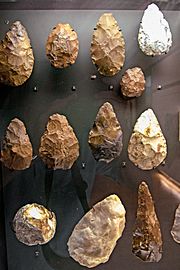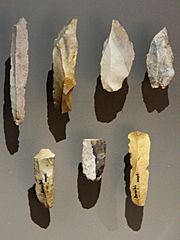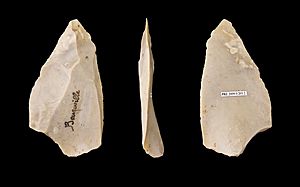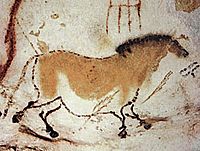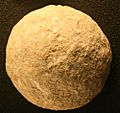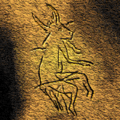Paleolithic facts for kids
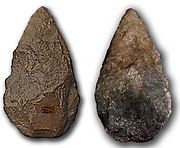
The Paleolithic, (or Palaeolithic), refers to the prehistoric period when stone tools were made by humans. They are found in the Great Rift Valley of Africa from about 3.3 million years ago. They were probably made by Australopithecines. They are found in Europe somewhat later, from about 1 million years ago (0.7 mya for Britain). The Paleolithic is by far the longest period of humanity's time, about 99% of human history. The geological period which corresponds to the Paleolithic is the Pleistocene.
Stone tools were not only made by our own species, Homo sapiens. They were made by all previous members of the genus, starting with relatively crude tools made by Homo habilis and Homo erectus. In Europe, the large-brained Neanderthal Man (Homo neanderthalensis) made tools of high quality, and was in turn outshone by the many tools made by our own species. These tools are the first cultural products which have survived.
The Paleolithic dates from about 2.6 million years ago and ended around 15,000BC with the Mesolithic in Western Europe, and with the Epipaleolithic in warmer climates such as Africa. The Paleolithic age began when hominids (early humans) started to use stones as tools for bashing, cutting and scraping. The age ended when humans began to make small, fine tools (Mesolithic) and finally when plant crops and have other types of agriculture (Neolithic). In some areas, such as Western Europe, the way that people lived was affected by the Ice age. The move towards agriculture started in the Middle East.
During the Paleolithic Age humans grouped together in small bands. They lived by gathering plants and hunting wild animals. As well as using stone tools, they used tools of wood and bone. They probably also used leather and vegetable fibers but these have not lasted from that time.
Contents
Cultures
Oldowan
The Oldowan is the archaeological term used to refer to the stone tool industry that was used by hominids during the earliest Paleolithic period. For a long time it was thought that the Oldowan was the earliest stone tool industry in prehistory, from 2.6 million years ago up until 1.7 million years ago. It was followed by the more sophisticated Acheulean industry. Oldowan tools were therefore the earliest tools in human history, and mark the beginning of the archaeological record. The term "Oldowan" is taken from the site of Olduvai Gorge in Tanzania, where the first Oldowan tools were discovered by the archaeologist Louis Leakey in the 1930s. Now it is realised that stone tools were used much earlier (3.3 million years ago) and that was definitely before the genus Homo had evolved.
It is not known for sure which species actually created and used Oldowan tools. It reached its peak with early species of Homo such as H. habilis and H. ergaster. Early Homo erectus appears to inherit Oldowan technology and refines it into the Acheulean industry beginning 1.7 million years ago. Oldowan tools are sometimes called pebble tools, so named because the blanks chosen for their production already resemble, in pebble form, the final product. Oldowan tools are sometimes subdivided into types, such as chopper, scrapers and pounders, as these seem to be their main uses.
Acheulean
Acheulean is the industry of stone tool manufacture by early humans of the Lower Paleolithic era in Africa and much of West Asia and Europe. Acheulean tools are typically found with Homo erectus remains. They are first developed out of the more primitive Oldowan technology some 1.8 million years ago, by Homo habilis.
It was the dominant technology for most of human history. More than a million years ago Acheulean tool users left Africa to colonize Eurasia. Their oval and pear-shaped hand axes have been found over a wide area. Some examples were finely made. Although it developed in Africa, the industry is named after the type site of Saint-Acheul, now a suburb of Amiens in northern France where some of the first examples were found in the 19th century.
John Frere was the first to suggest in writing a very ancient date for Acheulean hand-axes. In 1797 he sent two examples to the Royal Academy in London from Hoxne in Suffolk. He had found them in prehistoric lake deposits along with the bones of extinct animals and concluded that they were made by people "who had not the use of metals" and that they belonged to a "very ancient period indeed, even beyond the present world". His ideas were ignored by his contemporaries however, who held a pre-Darwinian view of human evolution.
Dating the Acheulean
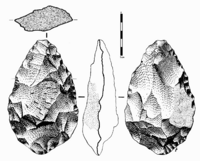
Radiometric dating, often potassium-argon dating, of deposits containing Acheulean material is able to broadly place Acheulean techniques from around 1.65 million years ago to about 100,000 years ago. The earliest accepted examples of the type, at 1.65 m years old, come from the West Turkana region of Kenya. Some think their origin might be as early as 1.8 million years ago.
In individual regions, this dating can be considerably refined; in Europe for example, Acheulean methods did not reach the continent until around 400 thousand years ago and in smaller study areas, the date ranges can be much shorter. Numerical dates can be misleading however, and it is common to associate examples of this early human tool industry with one or more glacial or interglacial periods or with a particular early species of human. The earliest user of Acheulean tools was Homo ergaster who first appeared about 1.8 million years ago. Some researchers prefer to call these users early Homo erectus. Later forms of early humans also used Acheulean techniques and are described below.
There is considerable time overlap in early prehistoric stone-working industries. In some regions Acheulean tool-using groups were contemporary with other, less sophisticated industries such as the Clactonian. Then, later, Acheulean tools occur at the same time as the more sophisticated Mousterian. The Acheulean was not a neatly defined period, but a tool-making technique which flourished especially well in early prehistory. Acheulean was a basic method for making stone tools which was shared across much of the Old World.
Clactonian

The Clactonian is an industry of European flint tool manufacture that dates to the early part of the interglacial period 400,000 years ago. Clactonian tools were made by Homo erectus rather than modern humans. Early, crude flint tools from other regions using similar methods are called either Clactonian or core & flake technology.
The Clactonian is named after finds made at Clacton-on-Sea in the English county of Essex in 1911. The artefacts found there included flint chopping tools, flint flakes and the tip of a worked wooden shaft along with the remains of a giant elephant and hippopotamus. Further examples of the tools have been found at sites in Swanscombe, Kent, and Barnham in Suffolk; similar industries have been identified across Northern Europe.
The Clactonian industry involved striking thick, irregular flakes from a core of flint, which was then employed as a chopper. The flakes would have been used as crude knives or scrapers. Unlike the Oldowan tools from which Clactonian ones derived, some were notched implying that they were attached to a handle or shaft.
The Clactonian industry may have co-existed with the Acheulean industry (which used handaxes). However, in 2004 there was an excavation of a butchered Pleistocene elephant near Dartford, Kent. Archaeologists recovered numerous Clactonian flint tools, but no handaxes. Since handaxes would be more useful than choppers to dismember an elephant carcass, this is evidence of the Clactonian being a separate industry. Flint of sufficient quality was available in the area, so probably the people who carved up the elephant did not have the knowledge to make handaxes.
Mousterian
The Mousterian is an industry of stone tools associated with Neanderthal Man, Homo neanderthalensis. It dates from about 300,000 years to about 30,000 years ago. There are up to thirty types of tools in the Mousterian as contrasted with about six in the Acheulean.
The Mousterian was named after the type site of Le Moustier, a rock shelter in the Dordogne region of France. Similar flintwork has been found all over unglaciated Europe and also the Near East and North Africa. Handaxes, long blades and points typify the industry. Overall, the items are more perfectly finished than any previous work. The method used to get the blades and flakes is called the Levallois technique. It is a prepared-core technique: the core is worked on so that a long, fine blade can be struck off. For this quality of work, a 'soft' hammer made of something like deer antler is necessary, rather than a stone hammer. The extra brain size of the Neanderthals is probably relevant to these advances.
The cultures which follow the Mousterian are all cultures of modern humans, Homo sapiens. It is characteristic of our species to produce many more tools, all specialised for particular tasks. There are at least 100 types of tools in the Upper Paleolithic compared to a maximum of 30 tools in the Mousterian.
Chronology of Paleolithic and following periods
The Paleolithic is sometimes divided into three (somewhat overlapping) periods which mark technological and cultural advances in different human communities:
- Paleolithic
- Lower Paleolithic (c2.6 or 2.5 million years ago–100,000 years ago)
- Middle Paleolithic (c300,000–30,000 years ago)
- Upper Paleolithic (c45,000 or 40,000–10,000 years ago).
After the Paleolithic follows the Mesolithic and Neolithic eras, which marks the end of Stone Age. The Bronze Age and the Iron Age come right after the Stone Age.
Overview of the main features of these periods
| Age | Period | Tools | Economy | Dwelling Sites | Society | Religion |
|---|---|---|---|---|---|---|
| Stone age | Paleolithic | Tools: sharpened flint or stone tools: hand axes, scrapers, wooden spears | Hunting and gathering | Mobile lifestyle – caves, huts, tooth or skin hovels, mostly by rivers and lakes | Tribes of plant gatherers and hunters (25-100 people) | Evidence for belief in the afterlife in the Upper Paleolithic: appearance of burial rituals and ancestor worship. Priests and sanctuary servants appear in prehistory. |
| Mesolithic (known as the Epipaleolithic in areas with no trend towards agricultural lifestyles) | Fine small tools: bow and arrow, harpoons, fish-basket, boats | Tribes and Bands | ||||
| Neolithic | Tools: chisel, hoe, plough, reaping-hook, grain pourer, barley, loom, pottery and weapons | Agriculture, Hunting and gathering, fishing and domestication | Farmsteads during the Neolithic and the Bronze Age Formation of cities during the Bronze Age | Tribes and chiefdoms in some Neolithic societies at the end of the Neolithic. States and civilisations during the Bronze Age. | ||
| Bronze Age | Writing; copper and bronze tools, potter's wheel | Agriculture; cattle-breeding; crafts, trade | ||||
| Iron Age | Iron tools | |||||
Venus figurines
Possibly among the earliest traces of art are Venus figurines. These are figurines (very small statues) of women, mostly pregnant. The figurines were found in areas of Western Europe to Siberia. Most are between 20,000 and 30,000 years old. Two figurines have been found that are much older: the Venus of Tan-Tan, dated to 300,000 to 500,000 years ago was found in Morocco. The Venus of Berekhat Ram was found on the Golan Heights. It has been dated to 200,000 to 300,000 years ago. It may be the one of the earliest things that show the human form.
Different kinds of stone, bones and ivory were used to make the figurines. Some are also made of clay which was then burned in a fire. This is one of the earliest known traces of the use of ceramics.
Today it is not known what the figurines meant to the people who made them. There are two basic theories:
- They may be representations of human fertility, or they may have been made to help it.
- They may represent (fertility) goddesses.
Scientists have excluded that these figurines were linked to the fertility of fields, because agriculture had not been discovered at the time the figurines were made.
The two figurines that are older may have mostly formed by natural processes. The Venus of Tan-Tan was covered with a substance that could have been some kind of paint. The substance contained traces of iron and manganese. The figurine of Berekhat Ram shows traces that someone worked on it with a tool. A study done in 1997 states that these traces could not have been left by nature alone.
Cave paintings
Cave paintings are paintings that were made on the walls or roofs of caves. Many cave paintings belong to the Palaeolothic Age, and date from about 15,000 to 30,000 years ago. Among the most famous are those in the caves of Altamira in Spain and Lascaux in France.p545 There are about 350 caves in Europe where cave paintings have been found. Usually, animals have been painted, like aurochs, bisons or horses. Why these paintings were done is not known. They are not simply decorations of places where people lived. The caves they were found in usually do not show signs that someone lived in them.
One of the oldest caves is that of Chauvet in France. Paintings in the cave fall into two groups. One has been dated to around 30,000 to 33,000 years ago, the other to 26,000 or 27,000 years ago.p546 The oldest known cave paintings, based on radiocarbon dating of "black from drawings, from torch marks and from the floors". As of 1999, the dates of 31 samples from the cave have been reported. The oldest paintings have been dated from 32,900±490 years ago.
Some archaeologists have questioned the dating. Züchner believe the two groups date from 23,000–24,000, and 10,000–18,000 years ago. Pettitt and Bahn believe the dating is inconsistent. They say the people at that periods of time painted things differently. They also do not know where the charcoal used to paint some things is from, and how big the painted area is.
People from the Paleolithic era drew well. They knew about perspective, and they knew of different ways to draw things. They also were able to observe the behaviour of animals they painted. Some of the paintings show how the painted animals behaved. The paintings may have been important for rituals.
Diet and nutrition
In general

Paleolithic hunting and gathering people ate leafy vegetables, fruit, nuts and insects, meat, fish, and shellfish. As there is little direct evidence, it is almost impossible to determine the relative proportions of plant and animal foods. There is a modern diet called paleolithic diet, but it has few things in common with the paleolitic diet of the time. Even the claim that most humans of a given period shared the same diet is problematic. The Paleolithic was an extended period of time. During that time, there were many technological advances, many of which had impact on human dietary structure. For example, humans probably did not possess the control of fire until the Middle Paleolithic, or tools necessary to engage in extensive fishing. On the other hand, both these technologies are generally agreed to have been widely available to humans by the end of the Paleolithic (consequently, allowing humans in some regions of the planet to rely heavily on fishing and hunting). In addition, the Paleolithic involved a substantial geographical expansion of human populations. During the Lower Paleolithic, ancestors of modern humans are thought to have been constrained to Africa east of the Great Rift Valley. During the Middle and Upper Paleolithic, humans greatly expanded their area of settlement, reaching ecosystems as diverse as New Guinea and Alaska. The also needed to adapt their diets to the local resources that were available.
Anthropologists have different opinions about the proportions of plant and animal foods consumed. Just as with still existing hunters and gatherers, there were many varied "diets" - in different groups -of fruit and vegetables. The relative proportions of plant and animal foods in the diets of Paleolithic people often varied between regions; in coilder regions, more meat was necessary. These regions were not populated by anatomically modern humans until 30,000-50,000 BP. It is generally agreed that many modern hunting and fishing tools, such as fish hooks, nets, bows, and poisons, weren't introduced until the Upper Paleolithic and possibly even Neolithic. The only hunting tools widely available to humans during any significant part of the Paleolithic period were hand-held spears and harpoons. There's evidence of Paleolithic people killing and eating seals and elands as far as 100,000 years BP. On the other hand, buffalo bones found in African caves from the same period are typically of very young or very old individuals, and there's no evidence that pigs, elephants or rhinos were hunted by humans at the time.
Developents
Another view is that until the Upper Paleolithic, humans were frugivores (fruit eaters) who supplemented their meals with carrion, eggs, and small prey such as baby birds and mussels. Only on rare occasions did they manage to kill and consume big game such as antelopes. This view is supported by studies of higher apes, particularly chimpanzees. Chimpanzees are the closest to humans genetically. They share more than 96% of their DNA code with humans, and their digestive tract is functionally very similar. Chimpanzees are primarily frugivores, but they could and would consume and digest animal flesh, given the opportunity. In general, their actual diet in the wild is about 95% plant-based, with the remaining 5% filled with insects, eggs, and baby animals. In some ecosystems, however, chimpanzees are predatory, forming parties to hunt monkeys. Some comparative studies of human and higher primate digestive tracts do suggest that humans have evolved to obtain greater amounts of calories from sources such as animal foods, allowing them to shrink the size of the gastrointestinal tract relative to body mass and to increase the brain mass instead.
Paleolithic peoples suffered less famine and malnutrition than the Neolithic farming tribes that followed them. This was partly because Paleolithic hunter-gatherers accessed to a wider variety natural foods, which allowed them a more nutritious diet and a decreased risk of famine. Many of the famines experienced by Neolithic (and some modern) farmers were caused or amplified by their dependence on a small number of crops. It is thought that wild foods can have a significantly different nutritional profile than cultivated foods. The greater amount of meat obtained by hunting big game animals in Paleolithic diets than Neolithic diets may have also allowed Paleolithic hunter-gatherers to enjoy a more nutritious diet than Neolithic agriculturalists. It has been argued that the shift from hunting and gathering to agriculture resulted in an increasing focus on a limited variety of foods, with meat likely taking a back seat to plants. It is also unlikely that Paleolithic hunter-gatherers were affected by modern diseases of affluence such as Type 2 diabetes, coronary heart disease and cerebrovascular disease, because they ate mostly lean meats and plants and frequently engaged in intense physical activity, and because the average lifespan was shorter than the age of common-onset of these conditions.
Large-seeded legumes were part of the human diet long before the Neolithic agricultural revolution, as evident from archaeobotanical finds from the Mousterian layers of Kebara Cave, in Israel. There is evidence suggesting that Paleolithic societies were gathering wild cereals for food use at least as early as 30,000 years ago. However, seeds, such as grains and beans, were rarely eaten and never in large quantities on a daily basis. Recent archeological evidence also indicates that winemaking may have originated in the Paleolithic, when early humans drank the juice of naturally fermented wild grapes from animal-skin pouches. Paleolithic humans consumed animal organ meats, including the livers, kidneys and brains. Upper Paleolithic cultures appear to have had significant knowledge about plants and herbs and may have, albeit very rarely, practiced rudimentary forms of horticulture. In particular, bananas and tubers may have been cultivated as early as 25,000 BP in southeast Asia. Late Upper Paleolithic societies also appear to have occasionally practiced pastoralism and animal husbandry, presumably for dietary reasons. For instance, some European late Upper Paleolithic cultures domesticated and raised reindeer, presumably for their meat or milk, as early as 14,000 BP. The Australian Aborigines have been consuming a variety of native animal and plant foods, called bushfood, for an estimated 60,000 years, since the Middle Paleolithic.
People during the Middle Paleolithic, such as the Neanderthals and Middle Paleolithic Homo sapiens in Africa, began to catch shellfish for food as revealed by shellfish cooking in Neanderthal sites in Italy about 110,000 years ago and Middle Paleolithic Homo sapiens sites at Pinnacle Point, in Africa around 164,000 BP. Although fishing only became common during the Upper Paleolithic, fish have been part of human diets long before the dawn of the Upper Paleolithic and have certainly been consumed by humans since at least the Middle Paleolithic. For example, the Middle Paleolithic Homo sapiens in the region now occupied by the Democratic Republic of the Congo hunted large 6-foot (1.8 m)-long catfish with specialized barbed fishing points as early as 90,000 years ago. The invention of fishing allowed some Upper Paleolithic and later hunter-gatherer societies to become sedentary or semi-nomadic, which altered their social structures. Example societies are the Lepenski Vir as well as some contemporary hunter-gatherers such as the Tlingit. In some instances (at least the Tlingit) they developed social stratification, slavery and complex social structures such as chiefdoms.
Related pages
Images for kids
-
An artist's rendering of a temporary wood house, based on evidence found at Terra Amata (in Nice, France) and dated to the Lower Paleolithic (400,000 years ago).
-
This skull, of Homo heidelbergensis, a Lower Paleolithic predecessor to Homo neanderthalensis and possibly Homo sapiens, dates to sometime between 500,000 and 400,000 BP.
-
Many great mammals such as woolly mammoths, woolly rhinoceroses, and cave lions inhabited the mammoth steppe during the Pleistocene.
-
Stone ball from a set of Paleolithic bolas
-
Bradshaw rock paintings found in the north-west Kimberley region of Western Australia.
-
Picture of a half-human, half-animal being in a Paleolithic cave painting in Dordogne. France. Archaeologists believe that cave paintings of half-human, half-animal beings may be evidence for early shamanic practices during the Paleolithic.
See also
 In Spanish: Paleolítico para niños
In Spanish: Paleolítico para niños


